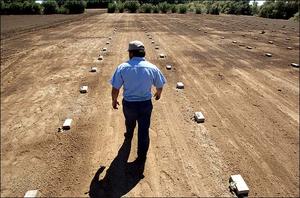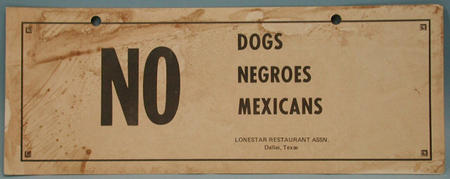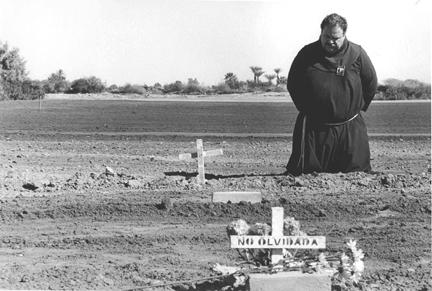November 2 marks the Day of the Dead, the holiday observed by people in Mexico and the country’s ever-expanding diaspora to remember friends, family, and loved ones—or individuals with whom one identifies—who have passed way. It is on days such as this that many visit cemeteries in places like Holtville, California, the burial place of hundreds of unidentified migrants who have perished since the mid-1990s while trying to enter the United States without authorization.
Holtville, a small town just 15 miles north of the U.S.-Mexico boundary in California’s Imperial Valley, was a place of formalized apartheid—at least in the early decades of the twentieth century. While Mexican workers were central to the town’s economy, Holtville had only one property owner of Mexican descent, a single restaurant proprietor, and a handful of residents in 1927.
For much of the twentieth century, overt anti-Mexican racism was the rule in the agriculturally rich Valley--as it was throughout the U.S-Mexico borderlands. As one man recalling the repeated humiliation his father endured as someone of Mexican origin living in southern California recounted, “In 1949, we were driving back from Mexicali [in Mexico], where my grandfather lived, and we tried to go into a restaurant in Westmorland [a town about 25 miles northwest of Holtville]. . . There was a sign at the door: ‘No Dogs or Mexicans Allowed.’”
Life today in Holtville is a different story. As in the Imperial Valley as a whole, a strong majority of Holtville’s residents are Latino. Moreover, Latinos hold a number of supervisory positions in the town government. Yet, like the U.S.-Mexico border region as a whole, the town remains tied to unjust systems that bring about premature death and disproportionate hardships for the non-white—systems that reflect profoundly unequal access to and control over the earth’s resources, and hierarchies along axes of race, class, gender, and nation.
It is on the outskirts of the self-proclaimed “Carrot Capital of the World” that one finds one of the more painful manifestations of such injustice: Holtville’s Terrace Park Cemetery, the back of which is a dirt-covered potter’s field, where the poor, destitute, and unidentified are buried.  Located there are the graves of migrants who died trying to traverse the desert or the treacherous waters of the All-American Canal, which irrigates the region’s industrial agricultural establishments. Their grave markers are simple, small concrete bricks engraved with “John Doe” or “Jane Doe.”
Located there are the graves of migrants who died trying to traverse the desert or the treacherous waters of the All-American Canal, which irrigates the region’s industrial agricultural establishments. Their grave markers are simple, small concrete bricks engraved with “John Doe” or “Jane Doe.”
On or near the Day of the Dead, members of religious communities, and migrant, labor, and human rights activists typically gather at potter’s fields and other locations in the U.S.-Mexico borderlands to pay tribute to ever-increasing number of migrants who have died trying to overcome the ever-hardening policing apparatus of exclusion. (Border-wide, the remains of over 6,000 migrants have been recovered since the mid-1990s, with 183 recovered in Arizona alone in the recently-ended Fiscal Year 2011, according to the Tucson-based Coalición de Derechos Humanos. Meanwhile, Mexico’s Ministry of Foreign Affairs counts 257 migrants deaths along the entire boundary in 2011 as of mid-October.) Often, the visitors mark the graves of unidentified migrants with crosses imprinted with the Spanish words “no olvidado”—“not forgotten.”
In doing so, they affirm the dignity of the dead—as well as of the living—while refusing to accept migrant fatalities in the name of the political and intellectual black hole called national security. They also highlight the importance of resistance to the dehumanizing systems that produce and reflect the injustices that make the borderlands, among other things, a site of brutality, institutionalized violence, and inhumanity. Moreover, they show that life can arise even at sites of death—if we struggle to ensure it does. Indeed, our survival as a species necessitates it. As the poet Carolyn Forché once wrote, “resistance to terror is what makes the world habitable.”
In the name of the dead and the living, may we make the world habitable—in the U.S.-Mexico borderlands and far beyond.
For more from the Border Wars blog, visit nacla.org/blog/border-wars. And now you can follow it on twitter @NACLABorderWars. See also the May/June 2011 NACLA Report, Mexico's Drug Crisis; the Jan/Feb 2009 NACLA Report, Taking on Policy in the Obama Era; and the May/June 2007 NACLA Report, Of Migrants & Minutemen.
Did you find this useful? Donate to NACLA

